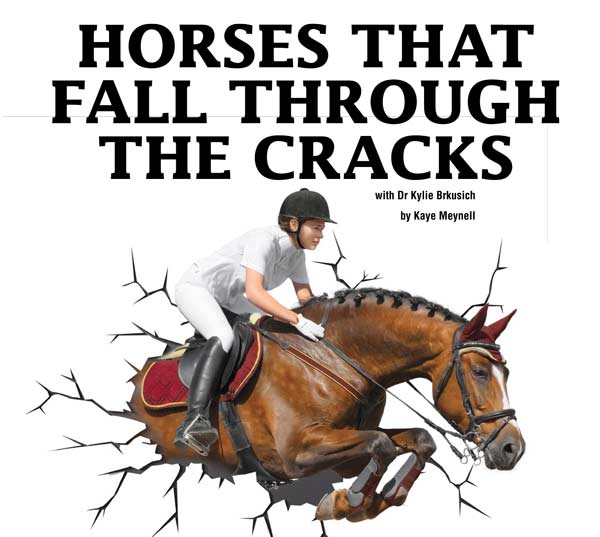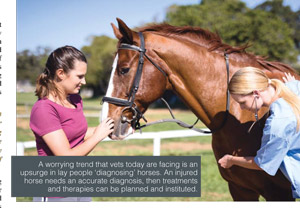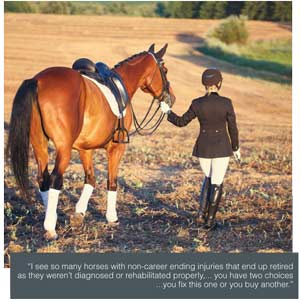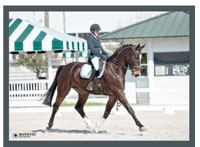Archived Backcopies
 August September 2019 August September 2019

|
| |

When confronted with unresolved pain or lameness in their horses, owners become frustrated and at times are emotionally and financially exhausted. These are the horses that are falling through the cracks and right into the retirement paddock…and they really don’t need to be there.
Equine veterinary medicine as we know it today is highly specialised and horse owners in Australia have some of the most highly regarded veterinarians in this field at their fingertips, not to mention access to impressive diagnostic and therapeutic tools.
Yet for all of the sophisticated machines and the vast array of medicines on offer, some horses are still being failed. Bouncing from treatment-to-treatment, these are the horses with pain that remains unmanaged or lameness that remains unresolved - despite them seemingly having had every possible work-up. These are the horses that might not be lame but continue to be ‘off’ or exhibit a decline in performance. For their owners, the future can seem bleak as hope for a solution steadily dwindles.
Hoofbeats writer Kaye Meynell talks with Dr Kylie Brkusich, DVM, about what becomes of these horses that fall through the cracks of the regular lameness work-up and what options remain for their owners to explore.
Be Sure To Seek An Accurate Diagnosis
It is easy to appreciate how a well-meaning owner can find themselves desperately trying any or all ‘treatments’ in a bid to find the one that will ‘fix’ their horse. Unfortunately, in the age of the Internet where information and opinions are readily available but often unreliable, owners can find themselves following the advice of those who have good intentions but who are unqualified to evaluate the situation at hand. A worrying trend that vets today are facing is an upsurge in lay people ‘diagnosing’ horses. The definition of a medical diagnosis is not limited solely to the detection or exclusion of disease but also encompasses prognosis – an evaluation of the disease including its progression, the patient’s survival and quality of life - and treatment plans. It is complex.
In Australia, there is legislation in place (the Veterinary Practice Act or the Veterinary Surgeons Act depending on the state) that makes it an offence for any person that is not a veterinary practitioner to do any restricted act of veterinary science.
Diagnosing, treating and providing management advice for physiological or psychological dysfunction, injury, and infectious disease in animals are all acts of veterinary science and therefore must only be done by a registered veterinary practitioner (Australian Veterinary Association, www.ava.com.au). In this manner, not only is the health, safety and wellbeing of the animal protected, but the prospect of a positive health outcome increased as a result of an accurate diagnosis given in a timely manner. 
“I constantly see social media posts encouraging owners to try a shotgun approach of therapies,” says Dr Kylie. “However, an injured horse needs an accurate diagnosis, then treatments and therapies can be planned and instituted. So often I have clients asking to make the symptoms go away instead of asking why they occur.”
Whilst there has been significant progression in our understanding of equine pain and physiological dysfunction in recent years (Equine Performance Medicine is a rapidly growing field), we still have some way to go when it comes to fully appreciating the impact that a compromised musculoskeletal system has on athletic ability and pain/lameness.
Many people assume that if the symptoms resolve the horse is now fixed and that is the end of the matter, however, long after the initial injury has healed there can be lasting effects on how the horse moves and uses its body.
“When a horse traps a leg in a fence, we are given the all-clear as soon as wounds heal but I often see significant undiagnosed pelvic trauma in these horses as a result of them trying to free their limb. If not treated, the now-altered biomechanics can eventually cause pain and/or further dysfunction,” says Dr Kylie.
Changes in performance then often ensue, and to varying degrees depending on the individual animal. A racehorse might be overtly lame and it is obvious to the owner that it cannot work; a dressage horse however only has to be unable to move its body properly (symmetrically) and it too is unable to do its job – the problem with this type of subtle change is that it is often not picked up on or managed properly.
Trust Your Gut
Having worked in the USA and UK for many years, the biggest change Dr Kylie faces practising in Western Australia is that fewer competition horses are trained in professional barns and ridden by professional riders.
“The professional rider will bring me a horse and just say it can’t turn right, whereas the owner/rider will blame themselves. They have a feeling the horse isn’t quite right but look everywhere except to the horse itself for the problem when in reality, 90% of the time, the problem is with the horse but the owner doesn’t realise. 
It’s like a big treasure hunt with everybody looking for the prize…whilst the treasure has been sitting underneath them the entire time! These are the horses that fall through the cracks; their movement feels ‘off’ so the owner has its joints injected and they carry on doing what they’ve always done with minimal improvement long-term because they aren’t addressing the real issue. The horse keeps moving in an incorrect way until it comes to a point whereby it becomes lame because it simply can’t compensate anymore. Horses in Australia are retiring so young!”
If it feels like something isn’t right with the horse, trust your instinct and seek help she says, “Sometimes, the owner has to do a little digging to find the practitioner they need; this work is specialised, and we are not on every corner.
I often joke that my business should be called ‘Port of last call vet services’ as I get all the challenging cases for which no one can pinpoint a definitive diagnosis!” Correctly identifying the underlying cause is the crucial first step with these horses and must be done well before rehab is considered to ensure a good outcome. “I regularly see a number of horses with severe generalised pain. These horses have been massaged, had Bowen therapy, been released, adjusted and injected and been fitted with new saddles, bits and girths. The riders blamed themselves, allergies, hormones and the weather! In all of these cases the horses actually had significant fascial disease that was never diagnosed.
The fascia is the largest organ in the body, covering the organs and all muscle planes and a generalised fasciitis or myofasciitis is extremely painful.
As a clinician, you must be able to determine whether the pain is in the muscles, ligaments, fascia, scar tissue, joints or osseous structures. Most of these horses were diagnosed with muscle pain or saddle issues (note that there is a large plane of fascia beneath the saddle position). Once identified I then treated the underlying cause of fascial reactivity. At this time, you cannot adjust or massage these horses without causing more pain; first they must be pain-free, so I wait until pain is reduced before tackling the compensations. Clients often report a significant reduction in pain and anxiety within 2 weeks of treating the underlying problem – then we can really start working to bring the horse back to good health and work.”
Rehab Is Key
Pain and compromise are there for a reason - find and treat the imbalance causing the body to be overwhelmed…don’t just inject a joint and carry on, asserts Dr Kylie.
“Look up, look back, think laterally, asses the gait, look at the body and find out why the horse travels as it does. Look at the horse first, then the gear, the training, the weather, the surface.
Don’t start therapies without a diagnosis. Stick to the rehab plan and we assess the horse every 2 weeks; if it’s not going well, we adjust the plan – rehabbing a horse is not the same as bringing a horse back into work.” Rehab is hard she comments, and not every ride will feel good or fun.
The 3 pillars of rehabilitation are:
1. Correct the pain
2. Correct the dysfunction
3. Strengthen
They are not:
1. Rest the undiagnosed lameness or injury
2. Commence work just like before
3. Repeat the injury
“Strengthening the dysfunction in a misdiagnosed sport horse can lead to career- ending injury. Unfortunately, I have seen this too many times. A diagnosis, no matter how frustrating, difficult or confronting, is key. The majority of horses I see are broken-but-sound horses. They have an undiagnosed (often major) problem but when you sort that out and fix the compromises, they are sound…this is so much better than not-broken-but- unsound horses!”
Be informed and be careful when searching for rehabilitation services for your horse warns Dr Kylie; it is important to ensure that the facility has staff that are qualified to make a diagnosis and prescribe a rehabilitation protocol.
“Rehabilitation plans should only be developed by a veterinarian, qualified physiotherapist or vet technician trained to do so. This may include working with a professional trainer who has vast experience in rehabilitating horses.”
Don’t Rule Out Alternative Modalities - But Be Selective
Although throughout her career Dr Kylie had found success with chiropractic she was still seeing horses that didn’t get better and after a chance encounter with a specialist in Texas, she registered for the International Veterinary Acupuncture Society training course. “As soon as I started the course I knew I wanted to dedicate the rest of my career to Eastern medicine, as it is based on treating the root cause of problems not just the symptoms. Shortly after completing my acupuncture certification I stopped practicing any general Western medicine. I do, however, absolutely believe in Western methods; I am an integrative practitioner and will refer clients back to their primary veterinarian for x-rays, bone scans and ultrasounds etc. if I see that they are needed. I am one part of a team that involves the western vet, the farrier, the dentist and other qualified therapists.
Getting everyone working together means your horse has its own dream team.”
Horse owners are certainly more aware of complementary and alternative therapies, with the use of herbal medicine, manual therapy (such as myofascial release/massage/chiropractic/Bowen therapy), laser therapy and acupuncture some of the more commonly known. If choosing to try any of the above modalities, it is important to seek out someone that is suitably qualified as all pose potential risks when practiced by those with inadequate education about horse anatomy and pathology and where no diagnosis has been confirmed. Look for providers who have had adequate training at accredited institutions. Be sure to check state/territory laws to ascertain whether it can be undertaken by a non-veterinarian.
Don’t Give Up
“I see so many horses with non-career ending injuries that end up retired as they weren’t diagnosed or rehabilitated properly,” comments Dr Kylie, going on to say that she considers it a privilege to improve the quality of life for horses. “I do not take the challenge lightly! I try every day to educate owners and riders to look at their horse more closely, to see when problems occur, not to ignore changes in gait or pain level.”
Rehab is not simply buying equipment, putting it on the horse and bringing it back into work. Unfortunately, anybody can buy rehabilitation equipment online and use it on a horse with very limited knowledge of whether what they are doing is appropriate and this can worsen the problem Dr Kylie cautions.
“Whilst the rehabilitation of the horse lies predominantly with the owner, this should only be after a professional has given them the knowledge and tools as to how to go about doing it properly.
We say it’s 10% vet work and 90% the owner/rider...and it can be very hard for them to get their horse going again. Getting owners to realise that their horse is broken but still sound is difficult, and so is assuring them that the horse still has a future because a lot of owners think they need to retire them. Yes, big-time competition horses have years and years invested in them, making retirement undesirable and rehab the more attractive option, but even if you don’t have a big-time horse, even if you just have a really nice horse with a great temperament that you love, you have two choices: you fix this one or you buy another … but then what will you do with this horse for the next 20 years if you decide to retire it?”
It is the owner who must put in the effort and make the difference reiterates Dr Kylie. “In America there are specialised rehab centres for horses, places that owners can send their horse away to be fully rehabilitated by a team of professionals, but these cost around $10,000 a month…that is the price of not being directly involved in your horse’s rehabilitation! My job is educating horse owners on when to get their horse on the float to go see a professional.
We can’t treat horses if the owner doesn’t make the decision that the horse needs our help. It’s about letting owners know that yes, their horse is compromised today but, with some hard work, still has a future.
Dr Kylie Brkusich BVMS
Dr Kylie graduated as a Bachelor of Veterinary Medicine and Surgery from Murdoch University in 1987 and, after 5 years in mixed practice, underwent training with the late Dr Sharon Willoughby, DVM, Veterinary Chiropractor and founder of the American Veterinary Chiropractic Association. She moved to Texas in 2005, gained a license to practice veterinary medicine in the USA, and completed further training in animal chiropractic. before starting her business, Performance Animal Chiropractic, in 2007. After completing an International Veterinary Acupuncture Society training course, Dr Kylie chose to exclusively practise Eastern medicine and focus on diagnosing and rehabilitating performance horses and, as an integrative practitioner, works with her clients’ primary veterinarian whenever it is required. Dr Kylie continues to develop her expansive knowledge and is currently completing certification as an Equine Rehabilitation Therapist with the Animal Rehab Institute in Florida – a course open only to veterinarians, chiropractors and physical therapists - to further her specialised skills. Dr Kylie now resides back in Western Australia providing diagnostic evaluations, chiropractic and acupuncture treatments, Chinese herbs, gait evaluation and laser therapy to horses. She continues to regularly travel back to the USA and to Victoria to work with performance horses.
www.facebook.com/PerformanceChiropracticandVetservices/
kylieaus@performanceanimalchiro.com
|